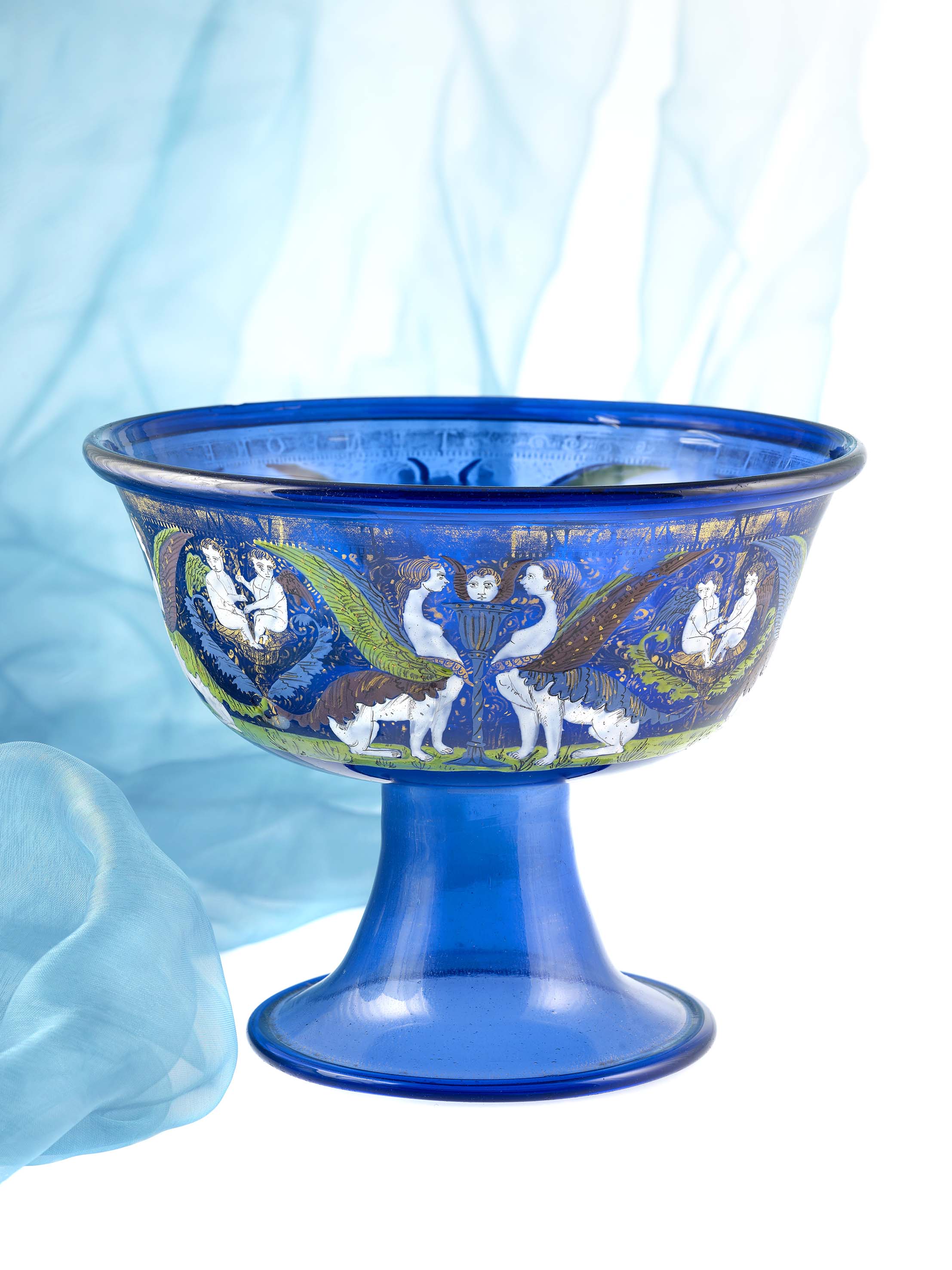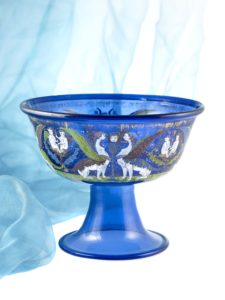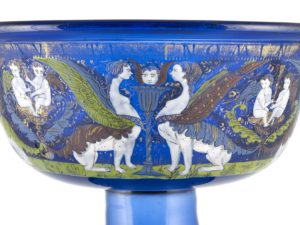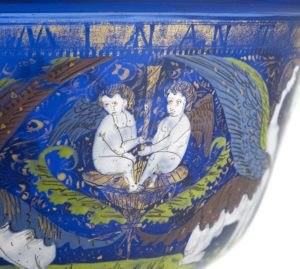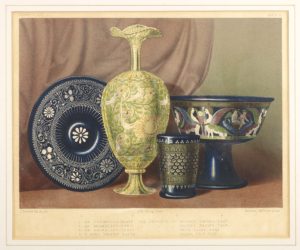Late 15th century.
Of rounded form and folded rim, painted with pairs of winged sphinxes opposing a cherub’s head emerging from a vase alternating with pairs of cherubs seated on gilt urns, on a grassy sword and reserved on a ground of gilt scrolling foliage, below a gilt inscribed ‘TENPORE FELICI MVLTI NOMINANTVR AMICI’ over a high trumpet foot with folded rim brushed with gilding.
16.5cm high by 20.8cm diameter.Provenance.
George Field
Baron Alphonse de Rothschild (1827-1905) Paris
Baron Edouard de Rothschild (1868-1949) Paris
Baron Batsheva de Rothschild (1914-1999) Tel Aviv
Rothschild Inv.nos.P48 and E de R 261(?)Exhibited
The Art Treasures of the United King- dom. Manchester,1857
Illustrated by J.B Waring, Catalogue of the Art. Treasures of the United Kingdom collected at Manchester in 1857, in the section headed ‘The Museum of Ornamental Art’, London (1858), Chromolithograph, pl.2
The inscription translates as ‘In times of abundance one has lots of friends’
The sphinx motif appears on a green beaker attributed to Venice,circa 1500, formerly in the Kunstgewerbe Museum,Berlin(see R Schmidt, Das Glass,Berlin,p.93,p156 and F.A.Dreier, ‘Ein venezianischer Emailglas- Pokal,Aus der Sammlung Lady Bagot’ Kunst & Antiquitaten, zeitschrift fur Kunstfreunde Sammler and Museen,Heft 111’ 1986’p56 pl 5. Although the beaker was probably destroyed during the Second World War Schmidt describes it, op cit, as decorated with sphinxes, cherub’s heads and putti. The putti on the present example bear a close resemblance to those on a blue-tinted standing bowl in the Cleveland Museum of Art, Ohio (ex collections Charles Stein,Paris, and Maurice de Rothschild ,Geneva) (see R.Barovier-Mentasti et al,exhibition catalogue, Mille anni Di rate del vetro a Venezia, 1982, p81. Nos 71ac, and R.von Strasse and W. Spiel,Dekoriertes Glas,1989,p28.pl 27)
No other blue-tinted Venetian standing bowl with a gilt band etched with an inscription is recorded in the literature. a part-coloured shallow bowl,however, in the Museo Ala Ponzone, Cromona, with a partial gilt amethyst-tinted trumpet-shaped foot,is also inscribed within a gilt border below the rim. This example was recorded in the museum’s collection at least as early as 1840 (see R.Barovier Mentasti et al.Les Gaes du Verre,p 176, no 51). Similar inscriptions also appear on five clear glass bowls from the late 15th century . See the example exhibited in the Museen Ariana, Geneva,1995 (illustrated Erwin Baumbgartner, Verre de Venise, pp31 and 91, 172)
One in the Victora and Albert Museum (see W.B Honey, handbook of the Collections,1964,p132C), another in the British. Museum, London (see Hugh. Tait The Golden Age of Venetian. Glass,1979, p.38, no 28) a fourth in the Wurttembergisches Landesmuseum, Stuttgart (formerly in the Ernesto Wolf Collection,see B.Klesse, European Glass from 155-1800. No 8) and another in the Louvre Museum, Paris (Inv 0A1119). Four of the bowls mentioned engraved in capital letters in the ‘antique’ on a gilt band applied to the exterior.George W. Field was born on the 13th November 1798 and lived at Ashurst. Park, a large house Set in its own grounds close to Tunbridge Wells,Kent. When he assembled his art collection Is unrecorded but Field appears to have been well-known as a collector of Renaissance and Mediaeval art to some of the leading connoisseurs of the day. On 17th September 1856 he was invited to lend items to the exhibition of the Art Treasures of the United Kingdom to be held in Manchester in 1857. the criteria for the choice of exhibits were largely based on the wide personal knowledge of British private collections by the noted German art historian Gustav Waagen. Amongst the numerous items inspected by J.B.Waring,the organiser of the Works of Art Section,the present lot was selected for display. Further 16th century items, including ivories, bronzes and wood carvings were also selected. From the extensive list of exhibits found in the City of Manchester archives, Field’s collection was both eclectic and diverse (M6/2/21) they included ‘Queen Elizabeth’s Prayer’. Book,silver gilt and enamelled, very rare and fine work’ (P206), ‘A very fine crystal cup formerly part of the Crown Jewels of France,lately the property of Louis Phillips’ 2 carved ebony chairs from Strawberry Hill’ (p140) and some fine Dutch 17th century oil paintings by several of the leading masters (M6/2/32). Of the glass that was returned to him after the closure of the exhibition ‘1 opal cup,1 Venetian bowl, blue and finely enamelled ,3 cups of Ruby glass and 2 Venetian glass vases mounted’ are recorded. In the introduction to the section of the exhibition catalogue devoted to ‘the. Museum of Ornamental Art’ Waring acknowledged the contribu- tions of Earl Cadogan,Lord de Tabley,Mr Field and the Duke of Buc- cleuch, as ‘amongst the most remarkable examples’ (Catalogue, 1857, p149) field’s glass was exhibited alongside that lent by Felix Slade who subsequently donated his extensive collection to the British Museum.
Blue-tinted glasses and especially footed bowls of this type are well known in the corpus of Venetian production of the 15th and early 16th.centuries.Indeed, Henry V111 of England is known to have had standing Cuppes of blewe glasses wt covers to they’d painted and uilte’ (See D Battle and S Cottle,Sotherby’s Concise encyclopaedia of. Glass,p60). In shape and form one of the closest related examples to the present lot is the famous blue glass mar- riage bowl, commonly known as ‘The Angelou. Barovier Cup’ ( In the Museo Vetrario, mutant- see Barovier(1982) p74-78,no 70. Angelo Barovier was until recently credited with the fine enamel decoration. he was widely praised as one ‘who knew the whole of the art of glass’ and had won the respect of Alphonse,King of Naples, the. French court and the. Duke of Milan. The Barovier Cup is however, now thought to date from 1470-1480’ some ten years after Angelo’s death in 1460.
As Hugh Tait has commented,almost nothing is know about the Venetians who decorated these chefs-d’ouuvres of the Renaissance and not one single glass can be identified as the work of a particular artist.
As Hugh Tait has commented,almost nothing is know about the Venetians who decorated these chefs-d’ouuvres of the Renaissance and not one single glass can be identified as the work of a particular artist.
In recent years the dating of Venetian enamelled and gilt blue-tinted glass has been assisted by excavations of burial mounds in the Russian Caucasus, an area originally under the control of the Mongul khans of the Golden Horde (1226-1502), the archaeological evidence indicates that such glass was produced in Venice and traded via Italian colonies established along the Silk Route in the 14th and 15th centuries.They include complete examples of purple/green and blue glass decorated with scale and dot and lozenge and flower ornament typical of much of the existing material ( see the article by Mark Kramarovsky).’the import and manufacture of glass in the territories of the. Golden Horde’ published by Rachel Ward (ed) Gilded and Enamelled Glass form the Middle East,British Museum,1998’pp96-100). Kramarovsky, a curator at the Hermitage Museum,St. Petersburg,refers to several coloured Venetian glass from the excavations now in the Museum’s collection including a blue glass tankard(fig 22.5) decorated in enamels and gilding with flowers in diamond-shaped frames,found in Digoria ( Northern Ossetia ,Caucasus).
For similar figurative decoration,The Weoley Cup, a late 15th century.
Venetian clear glass goblet, has a provenance as early as 1547.Presented to the Worshipful Company of Founders in London by its Master, Richard Weoley, in 1642-43, this goblet is crucial in the early dating of such glass. According to Weoley,he had purchased the cup from a family whose ancestors had brought it back from Boulogne at the time it surrendered to Henry V111 in 1546. This story is given credibility through the London hallmarks on the silver gilt foot,which can be dated to 1547 and thus provide the glass with an exceptionally early provenance(see the exhibition catalogue, gothic: Art for. England 1400-1547, Victoria and Albert. Museum,2003 p208.
Another glass gilded and enamelled vessel with provenance is the famous Fairfax cup,preserved in the V and A museum in its original bag from the 17th century, but dating from the late 15th century.
The date of the acquisition by the Rothschilds of this bowl for their famed collection of Venetian and Islamic enamelled glass is unknown, Nonetheless,it may not be entirely coincidental that. Baron Alphonse de Rothschild (1827-1905) married his English cousin Leonora in 1857.Her uncle. Sir Anthony Rothschild was a major contributor to the Manchester Art. Treasures exhibition in that same year, and may have come into contact with George. Field. It is possible that Alphonse and Leonora visited the exhibition.
X-Ray Fluorescence Analysis of an Enamelled Glass Bowl, Venice, Circa 1490
1st June 2015
Dr. K. Domoney Professor A.J. Shortland
Centre for Archaeological and Forensic Analysis Cranfield University, Shrivenham, Oxon SN6 8LA
Conclusion
The analysis of the glass and enamels have produced some clear patterns is terms of flux and colorant identification. Results are consistent with previous analytical data from collections of Renaissance Venetian glass and with traditional Renaissance Venetian glass recipes dating to the 15th and early 16th centuries. Evidence of later pigments and opacifiers such as chromium green, calcium antimonite and lead arsenate were not found.

